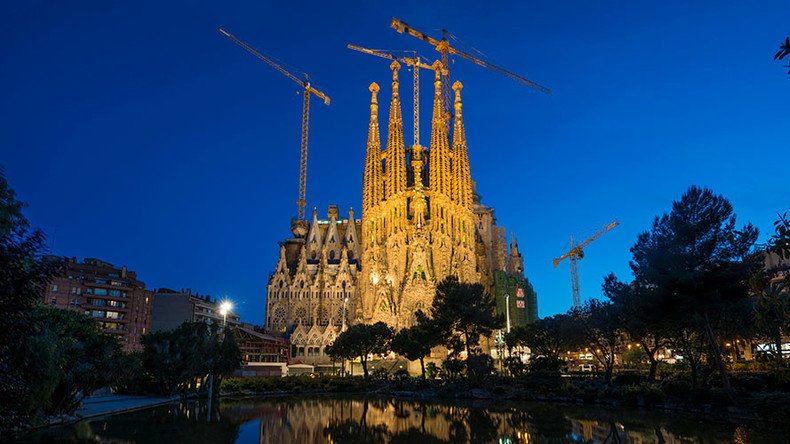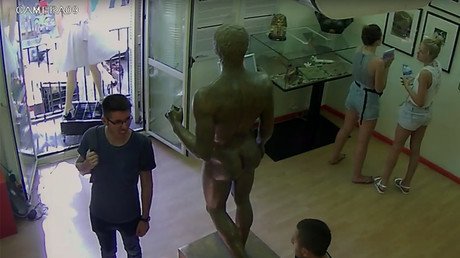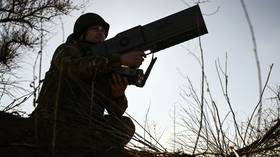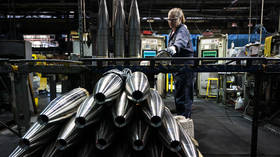Barcelona’s iconic Sagrada Familia was prime target of terrorists’ botched bombing plot – report

The Catalonian terrorist cell, responsible for the twin attacks in Barcelona and Cambrils, originally planned to carry out a major bombing campaign with explosive-laden vans. Antoni Gaudi’s unfinished cathedral masterpiece was reportedly their main target.
Wednesday's apparent accidental explosion at their Alcanar hideout forced the terrorists to adjust their sinister plans. The group of jihadists plotted to construct a number of bombs to blow up at least three targets in Barcelona, the Spanish online portal El Espanol reported Saturday.
[EN] On Sunday 20 August at 10:00 am, mass will be held in the #SagradaFamília for victims of the terrorist attack. Free entrance ...(1/2) pic.twitter.com/K0D0DMXgAv
— La Sagrada Família (@sagradafamilia) August 19, 2017
Citing police sources, the online publication reported that potential targets included Gaudi’s iconic masterpiece, the basilica of the Sagrada Familia. La Ramblas in Barcelona, the scene of the van attack on Thursday, was second on the list. The third potential target for the terrorists might have been the port area of Barcelona.
Attacks timeline: How terrorism hit #Barcelona & #Cambrilshttps://t.co/lZTO5pbSGa
— RT (@RT_com) August 18, 2017
The initial plan for the multiple attacks envisioned assembling up to three improvised explosive devices (IEDs). Some reports indicate that the jihadists mulled hiring a large truck, or several smaller vans to inflict a maximum carnage.
Catalan authorities have already revealed that the terrorist network planned a much bigger atrocity than the ones which unfolded in Barcelona and Cambrils Thursday and Friday.
DETAILS: At least 1 person died & 6 were injured in house explosion in #Alcanar, Catalonia https://t.co/ej1kqYzpTb
— RT (@RT_com) August 17, 2017
“They were preparing one or several attacks in Barcelona, and an explosion in Alcanar stopped this as they no longer had the material they needed to commit attacks of an even bigger scope,” said Josep Lluis Trapero of Catalonia's police at a news conference Friday evening.
The initial plan was scuppered when the terrorists allegedly mishandled the explosive material and accidentally blew themselves up in the safe house in Alcanar. It is believed that at least two suspects died in that explosion.
The accident apparently prompted other members of the terrorist cell to switch to plan B, staging the ramming attack on La Ramblas using a rented van that had no explosives.
A few hours later, five more members of the cell were shot dead by police as they ran over and stabbed people in Cambrils. These two attacks killed 14 and injured more than 130 people.
Examining the ruins of the Alcanar explosion site, investigators found an arsenal of explosive material; including dozens of tanks of butane gas and traces of the triacetate triperoxide (TATP) explosive, dubbed the 'Mother of Satan.'
Triacetone triperoxide has been used by Islamic State (IS, formerly ISIS/ISIL) and other terrorists before – the 7/7 bombings in London and the November 2015 Paris attacks. TATP which looks like a white powder is highly unstable and difficult to detect; but it can explode with a force that’s roughly 80 percent as strong as TNT. Terrorists presumably planned to detonate the gas by using TATP explosives.
If the terrorists’ original plan succeeded, the death toll might have been significantly higher. The Sagrada Familia is the most visited tourist attraction in Barcelona. In 2016, 4.5 million people entered the basilica's unfinished yet stunning interior, El Espanol reported.
UPDATE: Government to maintain level-four security alert in Spain, security to be reinforced at tourist areas https://t.co/SNUTbuuDmC
— RT (@RT_com) August 19, 2017
Construction of the Sagrada Familia began in March 1882 by Francisco de Paula del Villar. Antoni Gaudi accepted the commission in 1883 adapting the initial design of the Catholic Church sanctuary to his unique style.
From 1914 until his death in 1926, the Catalan architect dedicated himself exclusively to the work of the Holy Family cathedral. Following Gaudi's death, construction progressed slowly.
The unfinished facade was first lit in 1952 and nine years later the museum was opened to the public. So far, roughly 70 percent of the cathedral has been built. The basilica, which is part of a UNESCO World Heritage Site, should be fully completed by 2026.
Investigators believe the attacks in Barcelona and Cambrils were organized by a cell of at least 12 terrorists. Five of them were killed in Cambrils and four others detained. Authorities have also identified three others, two of whom could have died in Alcanar.
In the latest development, police raided the house of an imam in the town of Ripoll Saturday. The cleric, identified as Abdelbaki Es Satty, authorities believe, might have served as the spiritual leader of the terrorist cell involved in the dual attacks. The imam was last seen Tuesday according to his landlord, a day before the explosion in the village of Alcanar Platja.
On Saturday, Spanish authorities announced that the terrorist cell has been fully dismantled, but that the manhunt for other suspects is ongoing. “The cell has been completely dismantled,” Spain's interior minister Juan Ignacio Zoido told reporters.
“We can't say the investigation is finished until we locate or detain all those who we think form part of this terror cell,” added Joaquim Forn, interior minister of Catalonia. Police are still searching for Younes Abouyaaqoub, 22, who has not been ruled out as possibly being the van driver in Barcelona.















